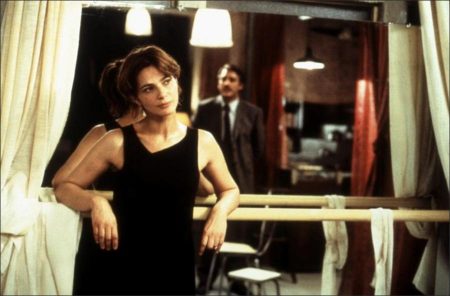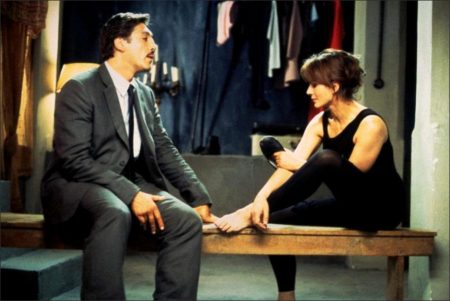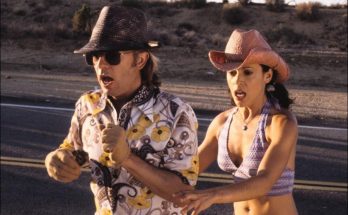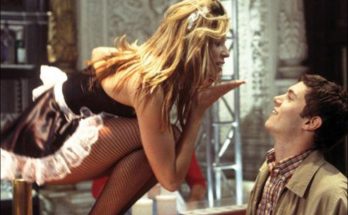Taglines: An honest man caught in a world of intrigue, power and passion.
The Dancer Upstairs movie storyline. The story of Detective Agustin Rejas, a man clinging to the hope of an impossible love in an impossible world. Tracking Ezequiel, a delusional anarchist who incites the downtrodden masses to join in his brutal revolution against the fascist government in their unnamed Latin American country, Rejas finds solace in his sense of self-respect and the joy that his daughter and wife bring him.
Then he meets Yolanda–his daughter’s soulfully beautiful ballet teacher–a woman who sparks his long-forgotten passions and represents all that is good and all that is corrupt in their troubled country. But she, who appears to be a shelter from the storm, may in actuality be the storm’s eye. Ultimately, as the revolution intensifies and the net closes around hunter and hunted alike, the dancer’s truth will prove as elusive as the revolutionary’s cause and the detective’s peace.
The Dancer Upstairs is a 2002 Spanish-American crime thriller film produced and directed by John Malkovich (in his directorial debut), and starring Javier Bardem, Juan Diego Botto and Laura Morante. The film is an adaptation of the book of the same name by Nicholas Shakespeare, who also wrote the screenplay.
The film was shot in Porto, Portugal. The original theatrical release included a quick scene (about 2–3 seconds) of a map of Lima, Peru. This scene is deleted from the DVD release. A lamppost sign reads: “When I hear the word culture, I reach for my pistol.” This is a quotation usually mis-attributed to Nazi leader Hermann Göring.
The seized videotape is labeled “Estado de sitio”; this happens to be the Spanish title for the film State of Siege by Costa Gavras. There turns out to be an execution on the tape. Later, portions of Gavras’ film itself are also seen on the tape. The wisecrack joke about “pubes on a coke can” is a reference to the Judge Clarence Thomas confirmation hearings.
Film Review for The Dancer Upstairs
An accomplished and ambitious directorial debut from John Malkovich, “The Dancer Upstairs” is adapted by the British writer Nicholas Shakespeare from his own novel, which itself was inspired by the real-life manhunt for the Peruvian Shining Path guerrilla commander Abimael Guzman.
The film’s setting is an unnamed South American country in the recent past, where a mysterious terrorist organisation is wreaking havoc with a series of bombings (often carried out by children) and assassinations of government representatives. Dead dogs are being strung up from lampposts, the animals daubed with references to Ezekiel, the messianic leader of the rebels.
An ex-lawyer turned policeman, Rejas (Bardem) is ordered by his superiors to head up a small team to track down the elusive Ezekiel. The inspector’s investigation leads him back to the countryside where he grew up and from where Ezekiel derives support from the impoverished population. But, back in the city, the married Rejas has fallen for his daughter’s ballet teacher Yolanda (Morante), a woman with secret political affiliations…
“The Dancer Upstairs” operates on various levels – as an investigative thriller, as a thwarted love story, and as portrait of the way a fundamentally corrupt society breeds support for terrorist movements. Bardem is outstanding as the straight-arrow Rejas, taunted by his boss for being the Gary Cooper type: the actor produces a solemn, dignified performance. He is well supported by the expressive Morante.
Yet Malkovich shows that there’s more to his talents than directing his actors. He intrigues us with an opening scene at a remote rural checkpoint where a car radio plays Nina Simone’s Who Knows Where the Time Goes. He carefully constructs a threatening atmosphere and, throughout the unhurried pacing, allows us to get a real sense of Rejas’ cramped, unfulfilling home life.
Impressively shot by José Luis Alcaine, it’s partly indebted to the political dramas of Costa-Gavras, whose “State of Siege” is watched by Rejas, although “The Dancer Upstairs” is less strident and melodramatic in its tone.
The Dancer Upstairs (2003)
Directed by: John Malkovich
Starring: Javier Bardem, Laura Morante, Juan Diego Botto, Elvira Mínguez, Alexandra Lencastre, Oliver Cotton, Luís Miguel Cintra, Javier Manrique, Marie-Anne Berganza, Natalia Dicenta
Screenplay by: Nicholas Shakespeare
Production Design by: Pierre-François Limbosch
Cinematography by: José Luis Alcaine
Film Editing by: Mario Battistel
Costume Design by: Bina Daigele
Set Decoration by: Laura Musso
Art Direction by: Pierre-François Limbosch
Music by: Alberto Iglesias
MPAA Rating: R for strong violence, and for language.
Distributed by: Fox Searchlight Pictures
Release Date: May 2, 2003
Views: 61






